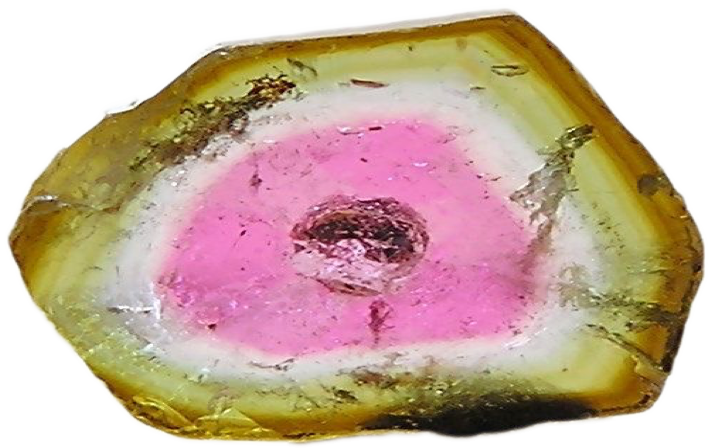The name Tourmaline comes from the Singhalese word (from northern India) “touramalli” which means “mixed colored stones”. Because tourmaline is found in so many different colors they are often confused with other types of gems. Tourmaline is not a single mineral, but a group of isomorphous minerals with an identical crystal lattice. Isomorphous minerals are a group of minerals with identical, or near identical crystal formation, but can be composed of different elements.
Tourmaline is described as a “crystalline boron silicate”. Each variety of tourmaline has its own chemical formula, with somewhat varying elements. Those elements include, but are not limited to; aluminum, boron, silicon, chromium, oxygen, hydrogen, potassium, sodium, calcium, magnesium, iron and lithium. Aluminum can be very toxic to the human body, but all of these elements are bonded to other elements in the crystal, so they are not free to enter into the human body.
The formula for the various tourmaline varieties are very complex, since they contain many elements and many combinations of those elements. Tourmalines are composed of some of the most complicated chemical formulas of all minerals.
Tourmaline has a six atom member ring crystal system.These crystals can occur in three forms; long and slender, as thick prisms or as column like crystals. Those crystals are usually triangular in cross-section, often with curved and striated faces. The ends of crystals are sometimes asymmetrical. Tourmaline is distinguished by its three-sided prisms. No other common mineral has three sides.
Tourmaline absorbs body heat and converts and then re-radiates that energy into the form of far infrared energy back into the body.
Those far infrared photons of light are picked up by chormophore molecules in our cells. Those choromphore molecules transfer that energy to the mitochondria. The mitochondria then will accelerate the rate of ATP formation. More ATP = A Greater Healing Capacity.
Our Cells Have 3 Priorities:
- To stay alive
- To do their job
- If the cells have enough energy left over, the cells can begin the healing process.
We are in many ways like our cells. When we are run down or fighting something off, our energy level is low, since our body is prioritizing whatever energy that we have available to us.
Tourmaline helps to put our body into a high energy efficiency mode. Applying a Tourma®Line product is like getting a continuous low level laser therapy 24/7. The process of converting body heat into far infrared is called energy thermal-photonic conversion. Patients often experience a feeling that Tourma®Tape is giving off heat and feels warm to them.
Tourmaline crystals all have a north and a south pole and generate a tiny ionic field. They are considered piezoelectric and when having a mechanical force, compression or vibration applied the tourmaline particles can generate negative ions. Negative ions are associated with a more alkaline body pH, they scavenge free radicals, reduce inflammation, stimulate healing at a more rapid rate, stimulate blood flow and increase blood oxygen levels. Negative ions are also considered anti-aging by many experts.
Humans generally can’t perceive this ionic energy, but animals seem to be able to. Since many people have told us that their dogs and cats won’t get off of their Tourma®Blankets, we are now starting to produce Tourma®Mats for Pets.
Tourmaline crystals are also pyroelectric, which means that they can actually generate a weak electric current from temperature change. This only happens with direct skin contact and can be perceived as a mild tingling sensation.
Tourmaline is found in two main geological forms; igneous rock, which are from volcanic lava, in particular with granite and in metamorphic rock, which change from another rock under pressure over time, such as schist and marble.
Tourmaline can also be found in minor amounts, in sedimentary rock, such as sandstone and conglomerate. California became a large producer of tourmaline in the early 1900s. Almost every color of tourmaline can be found in Brazil. In the late 1990s, copper-containing tourmaline was found in Nigeria. Africa and Afghanistan also have tourmaline mines.

